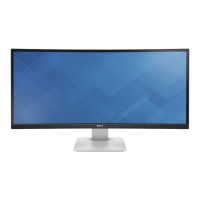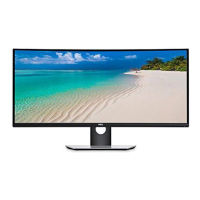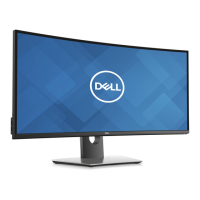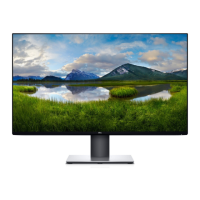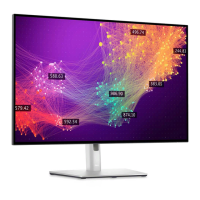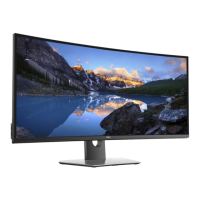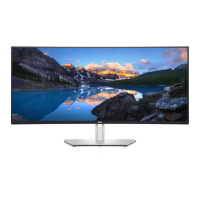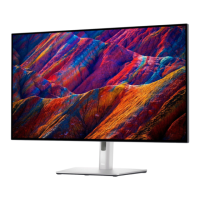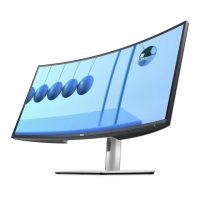Do you have a question about the Dell UltraSharp U3421WE and is the answer not in the manual?
Lists items included in the monitor package.
Details the monitor's key capabilities and specifications.
Identifies components visible on the front of the monitor.
Identifies components on the back of the monitor, including ports and controls.
Identifies ports and features on the bottom of the monitor.
Details the monitor's supported resolutions and scan ranges.
Lists the video modes the monitor supports via different inputs.
Specifies the predefined display modes and their parameters.
Provides technical details on power consumption and input signals.
Lists the monitor's dimensions, weight, and material properties.
Outlines operating conditions, compliant standards, and certifications.
Details the pin configuration for DisplayPort and HDMI connectors.
Explains the monitor's Plug and Play compatibility and USB interface details.
Provides information on USB transfer speeds, power, and port types.
Details the pinout for the RJ45 Ethernet connector.
Lists the operating systems supported by the monitor's network features.
Explains Dell's policy regarding monitor pixel defects.
Provides instructions for maintaining the monitor, including cleaning.
Instructions for attaching the monitor stand.
Steps for connecting various cables (DisplayPort, HDMI, USB-C, RJ45).
Guidance on managing cables for a tidy setup.
Procedure for detaching the monitor stand.
Instructions for mounting the monitor using a VESA compatible bracket.
Steps to turn the monitor on.
How to navigate and use the monitor's joystick control.
Guide to accessing and navigating the monitor's OSD settings.
Instructions for configuring the monitor to its maximum resolution.
How to set up and use the built-in KVM switch for controlling multiple computers.
Steps to configure the automatic KVM switching feature.
How to adjust tilt, swivel, vertical extension, and slant.
Procedure to check monitor functionality by running a self-test.
Tool to determine if screen abnormalities are monitor or computer related.
Table of common issues and their solutions.
Specific issues related to screen image and controls with solutions.
Troubleshooting common issues with USB ports and peripherals.
Solutions for no sound from external speakers.
Includes FCC notices and other regulatory compliance details.
Information on how to contact Dell support for assistance.
Lists items included in the monitor package.
Details the monitor's key capabilities and specifications.
Identifies components visible on the front of the monitor.
Identifies components on the back of the monitor, including ports and controls.
Identifies ports and features on the bottom of the monitor.
Details the monitor's supported resolutions and scan ranges.
Lists the video modes the monitor supports via different inputs.
Specifies the predefined display modes and their parameters.
Provides technical details on power consumption and input signals.
Lists the monitor's dimensions, weight, and material properties.
Outlines operating conditions, compliant standards, and certifications.
Details the pin configuration for DisplayPort and HDMI connectors.
Explains the monitor's Plug and Play compatibility and USB interface details.
Provides information on USB transfer speeds, power, and port types.
Details the pinout for the RJ45 Ethernet connector.
Lists the operating systems supported by the monitor's network features.
Explains Dell's policy regarding monitor pixel defects.
Provides instructions for maintaining the monitor, including cleaning.
Instructions for attaching the monitor stand.
Steps for connecting various cables (DisplayPort, HDMI, USB-C, RJ45).
Guidance on managing cables for a tidy setup.
Procedure for detaching the monitor stand.
Instructions for mounting the monitor using a VESA compatible bracket.
Steps to turn the monitor on.
How to navigate and use the monitor's joystick control.
Guide to accessing and navigating the monitor's OSD settings.
Instructions for configuring the monitor to its maximum resolution.
How to set up and use the built-in KVM switch for controlling multiple computers.
Steps to configure the automatic KVM switching feature.
How to adjust tilt, swivel, vertical extension, and slant.
Procedure to check monitor functionality by running a self-test.
Tool to determine if screen abnormalities are monitor or computer related.
Table of common issues and their solutions.
Specific issues related to screen image and controls with solutions.
Troubleshooting common issues with USB ports and peripherals.
Solutions for no sound from external speakers.
Includes FCC notices and other regulatory compliance details.
Information on how to contact Dell support for assistance.
| Pixel pitch | 0.2325 x 0.2325 mm |
|---|---|
| Pixel density | 109 ppi |
| Response time | 8 ms |
| Backlight type | LED |
| Display diagonal | 34.1 \ |
| Display technology | LCD |
| Native aspect ratio | 21:9 |
| Vertical scan range | 48 - 85 Hz |
| Maximum refresh rate | 60 Hz |
| Response time (fast) | 5 ms |
| Horizontal scan range | 30 - 89 kHz |
| sRGB coverage (typical) | 100 % |
| Contrast ratio (typical) | 1000:1 |
| Display number of colors | 1.073 billion colors |
| Display brightness (typical) | 300 cd/m² |
| HDMI | Yes |
| DisplayPort version | 1.4 |
| USB upstream port type | USB Type-B, USB Type-C |
| VGA (D-Sub) ports quantity | 0 |
| USB Type-A downstream ports quantity | 4 |
| VESA mounting | - |
| AC input voltage | 120 - 230 V |
| AC input frequency | 50 - 60 Hz |
| Energy efficiency scale | A to G |
| Power consumption (max) | 210 W |
| Power consumption (off) | 0.2 W |
| Power consumption (standby) | 0.3 W |
| Power consumption (typical) | 31.6 W |
| RMS rated power | 10 W |
| Product color | Black |
| Market positioning | Graphics design |
| Harmonized System (HS) code | 85285210 |
| Height (with stand) | - mm |
|---|---|
| Weight (with stand) | 11650 g |

